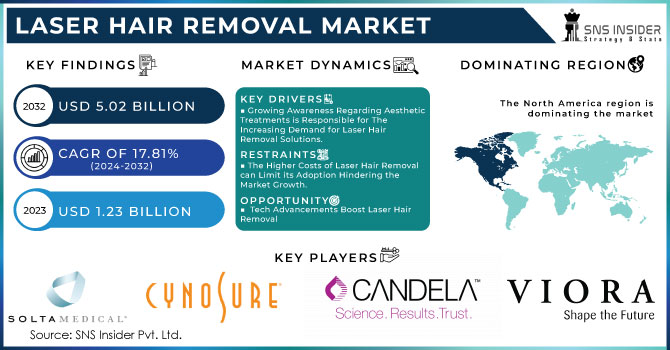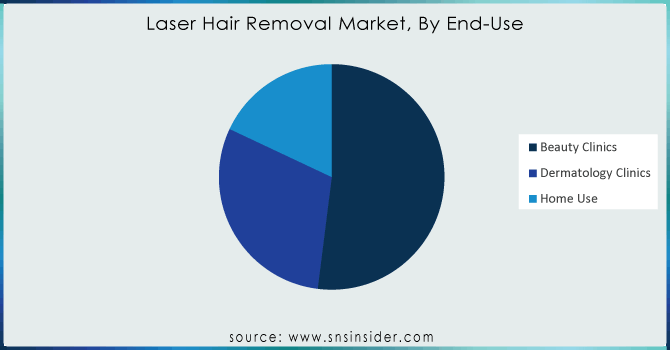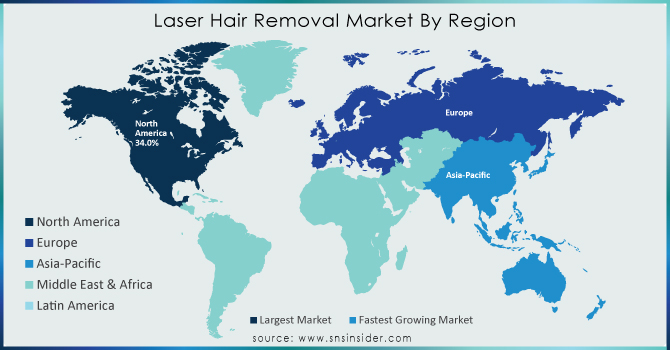Laser Hair Removal Market Report Scope & Overview:

Get more information on Laser Hair Removal Market - Request Sample Report
The Laser Hair Removal Market Size was valued at USD 1.23 billion in 2023 and is witnessed to reach USD 5.02 billion by 2032 and grow at a CAGR of 17.81% over the forecast period 2024-2032.
The global laser hair removal market is driven by several factors that include growing demand and acceptance of cosmetic procedures, increasing awareness about appearance among the population leading to increased expenditure on hair treatment aesthetics, & rising incidence of folliculitis. One of the key trends is growing consumer preference for minimally invasive cosmetics procedures which has resulted in demand for hair reduction solutions based on longevity. This trend is innovation-fueled as improvements in laser technology are making treatments safer, more effective, and more accessible. New advancements such as diode lasers & Alexandrite lasers can treat more skin colors and hair types than ever before treatment is both more effective and called inclusive.
Increasing number of clinics & medical spas to provide laser hair removal services across the market, especially in urban areas. These include wider deployments and increasing investments in research and development by leading industry participants to launch sophisticated, less complex laser devices. Further, the rising preference for home-based treatments is driving demand for at-home laser hair removal devices and scaling up market potential.
The U.S. Food and Drug Administration (FDA) imposes strict criteria that must be met before approval of such devices is obtained, significantly increasing safety but maintaining efficacy at high levels. A report from the American Society of Plastic Surgeons shows use has increased every year, in line with greater popularity and demand for such treatments. The government's promotion of medical tourism in countries such as India, Thailand, and Mexico is expected to further drive the market growth by attracting overseas patients traveling for lower-cost but high-quality aesthetic solutions.
One of the other significant trends observed in this market is a population with increasing disposable incomes and altering lifestyles besides developing regions. This change in the economy is allowing more patients or consumers to afford cosmetic treatments, such as laser hair removal. Effective marketing strategies and growing consumer awareness through industry players have led to a change from stereotypes that laser hair removal is painful, taking care of safety concerns by new customers thereby increasing the market penetration. These factors will contribute to the rapid growth of the laser hair removal market during the projected timeframe.
MARKET DYNAMICS:
KEY DRIVERS:
-
Growing awareness regarding aesthetic treatments is responsible for the increasing demand for laser hair removal solutions.
-
Raising acceptance of laser hair removal for long-term hair reduction procedures is boosting the market growth.
RESTRAINTS:
-
Substantial risk of burns, scarring including pigmentation changes are hindering laser hair removal market growth.
-
The higher costs of laser hair removal can limit its adoption hindering the market growth.
OPPORTUNITY:
-
Technological advancements are offering a lucrative growth opportunity for laser hair removal systems.
-
Rising trends for personalized treatment are responsible for the laser hair removal market growth during upcoming years.
KEY MARKET SEGMENTATION:
By Type
-
Diode
-
Nd: YAG
-
Alexandrite
-
Others
The segment of diode lasers held the most significant revenue share of 38% in the global market concerning laser hair removal because these provide higher precision. It allows diode lasers to safely focus on only one part of the body and melt away your hair without any damage due to its surrounding skin. Additionally, the moderate time consumed for timely removal of hair based on body part and amount is escalated in product trend. The results on skin with fairer complexion may not be as satisfactory compared to coarse, terminal hair. Though the manufacturers are making strides at creating similar effects for light terminal hair. They treat bigger body parts and do so at a much faster rate of repetition. This will have a substantial impact on the market generation of diode lasers in the future.
By End-Use
-
Beauty Clinics
-
Dermatology Clinics
-
Home Use
The beauty clinics segment accounted for the largest revenue share of around 54% in laser hair removal. Beauty clinic specialists are also familiar with modern laser hair removal devices that were introduced. There are higher demands of treatment in this age group since adults and elderly fellow citizens form a big part (or gradually bigger) within the society. Furthermore, the growing demand for non-invasive hair removal treatment on a global level is boosting the segment. If you compare this treatment with traditional treatments like wax and hair plucking laser offers a completely painless technique to remove hair. Therefore, the growing trend of targeted aesthetic treatment in addition to other segment factors is now driving market growth.

Need any customization research on Laser Hair Removal Market - Enquire Now
REGIONAL COVERAGE:
-
North America
-
US
-
Canada
-
Mexico
-
-
Europe
-
Eastern Europe
-
Poland
-
Romania
-
Hungary
-
Turkey
-
Rest of Eastern Europe
-
-
Western Europe
-
Germany
-
France
-
UK
-
Italy
-
Spain
-
Netherlands
-
Switzerland
-
Austria
-
Rest of Western Europe
-
-
-
Asia Pacific
-
China
-
India
-
Japan
-
South Korea
-
Vietnam
-
Singapore
-
Australia
-
Rest of Asia Pacific
-
-
Middle East & Africa
-
Middle East
-
UAE
-
Egypt
-
Saudi Arabia
-
Qatar
-
Rest of Middle East
-
-
Africa
-
Nigeria
-
South Africa
-
Rest of Africa
-
-
-
Latin America
-
Brazil
-
Argentina
-
Colombia
-
-
Rest of Latin America
REGIONAL ANALYSIS:
In 2023, North America led the global laser hair removal market with 34% of the market on account of rising demand for hair-reducing treatment coupled with a high number well well-equipped dermatology clinics as well to increase tag skilled professionals propelling the regional growth. In North America, aesthetic lasers are widely used by professionals for different purposes. Additionally, the existence of several players in this region is projected to boost the market growth across these regions. Back in June 2020, Venus Concept said it had secured FDA 510(k) clearance for its flagship product, the Venus Epileve. This is designed to manage and remedy hair removal, permanent reduction in the number of hairs, and pseudofolliculitis U.S. market frontiers New Hope Solta Medical announced in March 2021, that the Clear+Brilliant Touch laser system is available that delivers an increasingly differentiated and integrated treatment procedure through extends to patients of all ages and suits to everyone’s skin types.

KEY PLAYERS:
Major market players are trying to adopt some of the growth strategies, such as mergers and acquisitions with existing devices launched by promotional events & technologists. The major market players include Viora, Cynosure, Solta Medical, Inc., Candela Corporation, Lumenis Ltd., Cutera, Fotona, Venus Concept, Alma Lasers, Syneron Medical Ltd. & other players.
RECENT DEVELOPMENTS
-
In March 2023, Alma Lasers Ltd. acquired PhotonMed International Part of this involved Alma making significant investments by paying 270 MM RMB to acquire a majority stake in the business (60%) and become the leading shareholder for a newly formed joint venture. The acquisition has been viewed as a major accomplishment by Alma Lasers Ltd. in its initiative to expand and solidify its hold on the Chinese markets.
-
In March 2021, Boston Scientific acquired Lumenis Ltd., engaged in developing and commercializing energy-based medical solutions.
| Report Attributes | Details |
| Market Size in 2023 | US$ 1.23 Billion |
| Market Size by 2032 | US$ 5.02 Billion |
| CAGR | CAGR of 17.81% From 2024 to 2032 |
| Base Year | 2023 |
| Forecast Period | 2024-2032 |
| Historical Data | 2020-2022 |
| Report Scope & Coverage | Market Size, Segments Analysis, Competitive Landscape, Regional Analysis, DROC & SWOT Analysis, Forecast Outlook |
| Key Segments | •By Type (Diode, Nd: YAG, Alexandrite & Others) •By End-Use (Beauty Clinics, Dermatology Clinics, Home Use) |
| Regional Analysis/Coverage | North America (US, Canada, Mexico), Europe (Eastern Europe [Poland, Romania, Hungary, Turkey, Rest of Eastern Europe] Western Europe] Germany, France, UK, Italy, Spain, Netherlands, Switzerland, Austria, Rest of Western Europe]), Asia Pacific (China, India, Japan, South Korea, Vietnam, Singapore, Australia, Rest of Asia Pacific), Middle East & Africa (Middle East [UAE, Egypt, Saudi Arabia, Qatar, Rest of Middle East], Africa [Nigeria, South Africa, Rest of Africa], Latin America (Brazil, Argentina, Colombia, Rest of Latin America) |
| Company Profiles | Fotona, Viora, Cynosure, Solta Medical, Inc., Candela Corporation, Lumenis Ltd., Cutera, Venus Concept, Alma Lasers, Syneron Medical Ltd. & other players |
| Key Drivers | •Growing Awareness Regarding Aesthetic Treatments is Responsible for The Increasing Demand for Laser Hair Removal Solutions. •Raising Acceptance of Laser Hair Removal for Long-Term Hair Reduction Procedures Is Boosting the Market Growth. |
| RESTRAINTS | •Substantial Risk of Burns, Scarring including Pigmentation Changes are Hindering Laser Hair Removal Market Growth. •The Higher Costs of Laser Hair Removal can Limit its Adoption Hindering the Market Growth. |

